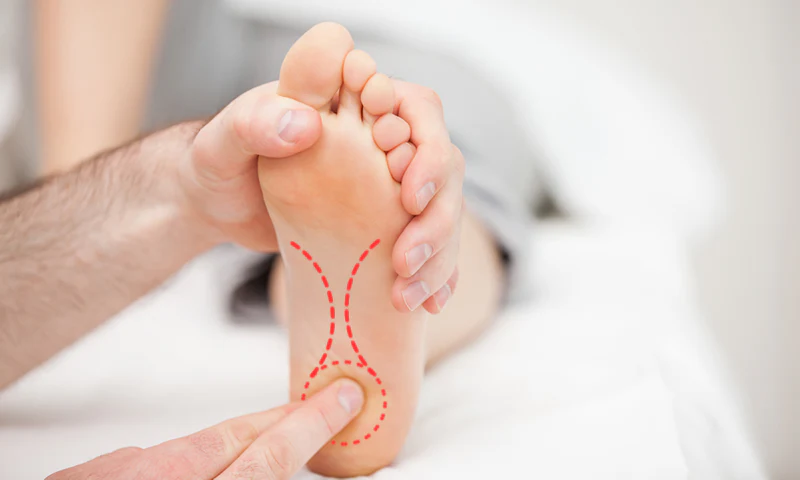Understanding and Alleviating Bottom of Heel Pain: Causes, Treatments, and Prevention

Table of Contents
ToggleIntroduction
Bottom of heel pain, often referred to as plantar heel pain, is a common complaint affecting many individuals worldwide. This type of pain can significantly impact daily activities, making it difficult to walk, run, or even stand for prolonged periods. Understanding the causes, treatments, and preventive measures can help alleviate discomfort and improve quality of life.
Causes of Bottom of Heel Pain
There are several potential causes for pain at the bottom of the heel, with plantar fasciitis being the most common. Other causes include heel spurs, Achilles tendonitis, and nerve compression.
- Plantar Fasciitis: The plantar fascia is a thick band of tissue that runs across the bottom of the foot, connecting the heel bone to the toes. Inflammation of this tissue, often due to overuse or stress, leads to plantar fasciitis, characterized by sharp heel pain, particularly in the morning or after periods of inactivity.
- Heel Spurs: These are bony growths that develop on the underside of the heel bone. They are often associated with plantar fasciitis and result from chronic strain on foot muscles and ligaments.
- Achilles Tendonitis: Inflammation of the Achilles tendon, which connects the calf muscles to the heel bone, can cause pain at the back and bottom of the heel. This condition is commonly seen in runners and individuals who engage in activities that involve a lot of jumping.
- Nerve Compression: Conditions such as tarsal tunnel syndrome, where a nerve is compressed in the foot, can lead to heel pain. This type of pain is often accompanied by tingling or numbness in the foot.
Symptoms of Bottom of Heel Pain
The primary symptom of bottom of heel pain is discomfort or pain at the underside of the heel. The pain can vary in intensity and is often described as sharp or stabbing, especially with the first steps in the morning or after long periods of sitting. Other symptoms may include:
- Swelling around the heel
- Redness or warmth
- Difficulty walking or standing for long periods
- Pain that worsens after exercise
Diagnosis
Diagnosing the cause of heel pain typically involves a physical examination by a healthcare provider. They may ask about your symptoms, medical history, and daily activities. Diagnostic tests, such as X-rays or MRI scans, might be recommended to rule out fractures or other conditions.
Treatment Options
Treatment for bottom of heel pain depends on the underlying cause. Here are some common approaches:
- Rest and Ice: Resting the affected foot and applying ice can help reduce inflammation and pain. It is essential to avoid activities that exacerbate the pain.
- Stretching Exercises: Stretching the calf muscles, Achilles tendon, and plantar fascia can relieve tension and reduce pain. Exercises such as towel stretches, calf stretches, and plantar fascia stretches are often recommended.
- Orthotic Devices: Custom orthotics or shoe inserts can provide support and alleviate pressure on the heel. These devices help correct foot mechanics and distribute weight more evenly.
- Medication: Over-the-counter pain relievers, such as ibuprofen or acetaminophen, can help manage pain and reduce inflammation. In some cases, corticosteroid injections may be administered for more severe pain.
- Physical Therapy: A physical therapist can design a personalized exercise program to strengthen the foot and leg muscles, improve flexibility, and promote healing.
- Night Splints: Wearing night splints keeps the foot in a dorsiflexed position overnight, stretching the plantar fascia and Achilles tendon. This can help reduce morning pain.
- Shock Wave Therapy: Extracorporeal shock wave therapy (ESWT) is a non-invasive treatment that uses sound waves to stimulate healing in the affected area.
- Surgery: In rare cases, when conservative treatments fail to alleviate the pain, surgical intervention may be considered. Procedures such as plantar fascia release or removal of heel spurs may be performed.
Prevention Tips
Preventing bottom of heel pain involves adopting healthy habits and making lifestyle adjustments. Here are some tips to help prevent heel pain:
- Wear Proper Footwear: Choose shoes that provide adequate arch support, cushioning, and a proper fit. Avoid high heels and shoes with insufficient support.
- Maintain a Healthy Weight: Excess weight can put additional stress on your feet, leading to heel pain. Maintaining a healthy weight can help reduce this pressure.
- Gradual Activity Increase: If you’re starting a new exercise routine, gradually increase the intensity and duration to avoid overloading your feet.
- Stretch Regularly: Incorporate stretching exercises into your daily routine to maintain flexibility in your feet and calves.
- Warm Up Before Exercise: Always warm up before engaging in physical activities to prepare your muscles and prevent injuries.
- Avoid Walking Barefoot on Hard Surfaces: Walking barefoot on hard surfaces can put undue stress on your heel. Use supportive footwear even at home.
Conclusion
Bottom of heel pain can be a debilitating condition, but with proper understanding, diagnosis, and treatment, it is manageable. By adopting preventive measures and seeking appropriate medical care, individuals can alleviate pain and improve their quality of life. If you experience persistent heel pain, consult a healthcare professional to determine the underlying cause and receive tailored treatment. Remember, early intervention is key to preventing chronic pain and complications.








